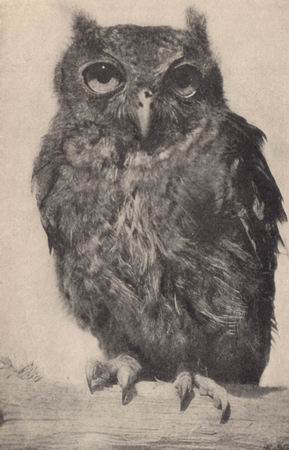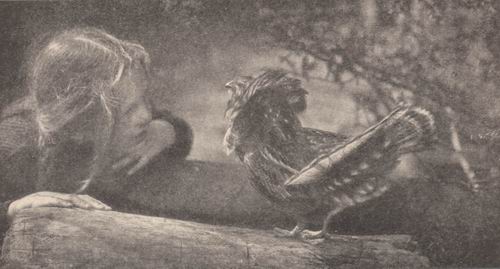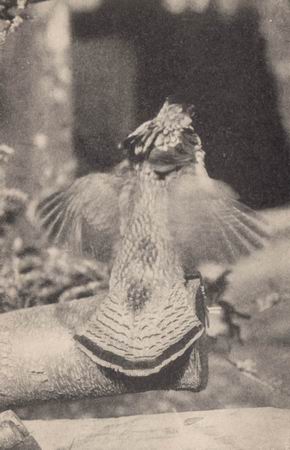|
1999-2004 (Return to Web Text-ures) |
Click Here to return to Birds Every Child Should Know Content Page Click Here to return to last Chapter |
 (HOME) |
|
1999-2004 (Return to Web Text-ures) |
Click Here to return to Birds Every Child Should Know Content Page Click Here to return to last Chapter |
 (HOME) |
|
CHAPTER XVI
MOURNER, WHISTLER, AND DRUMMER MOURNING DOVE BOB-WHITE RUFFED GROUSE MOURNING DOVE Called also: Carolina Dove DO NOT waste any sympathy on this incessant love-maker that slowly sings coo-o-o, ah-coo-o-o-ooo-o-o-ooo-o-o, in a sweetly sad voice. Really he is no more melancholy than the plaintive pewee but, on the contrary, is so happy in his love that his devotion has passed into a proverb. Nevertheless, the song he sings to his "turtle dove" sounds more like a dirge than a rapture. While she lives, there is no more contented bird in the woods. Dove lovers are quite self-sufficient. Their larger cousins, the wild pigeons, that once were so abundant, depended on friends for much of their happiness and lived in enormous flocks. Now only a few pairs survive in this land of liberty to refute the adage "In union there is strength." Because millions of pigeons slept in favourite roosts many miles in extent, they were all too easily netted, and it did not take greedy men long to turn the last flock into cash. Happily, doves preserved their race by scattering in couples over a wide area -- from Panama, in winter, as far north as Ontario in warm weather. Not until nursery duties, which begin early in the spring, are over, late in summer, do they give up their shy, unsocial habits to enjoy the company of a few friends. When they rise on whistling wings from tree-bordered fields, where they have been feeding on seeds and grain, not a gun is fired: no one cares to eat them. Only the cuckoo of our common birds builds so flimsy a nest as the dove's adored darling. I am sorry to tell you she is a slack, incompetent housekeeper, but evidently her lover is blind to every fault. What must the expert phoebe think of such a poorly made, untidy cradle, or that bustling, energetic housewife, jenny Wren, or the tiniest of clever architects, the hummingbird? It is a wonder that the dove's two white eggs do not fall through the rickety, rimless, unlined lattice. How scarred and bruised the naked bodies of the twins must be by the sticks! Like pigeons, hummingbirds, flickers, and some other feathered parents, doves feed their fledglings by pumping partly digested food -- "pigeon's milk " -- from their own crops into theirs. When they leave the open woodlands to take a dust bath in the road, or to walk about and collect gravel for their interior grinding machines, or to get a drink of water before going to sleep, you may have a good look at them. As they walk, they bob their heads in a funny manner of their own. They are bluish, fawn-coloured birds about a foot long. The male has some exquisite metallic colours on his neck, otherwise he resembles his best beloved. Both wear black crescent patches on their cheeks. All the feathers on their long, pointed tails, except the two largest central ones, have a narrow, black band across the end and are tipped with white. The breast feathers shade from pinkish fawn to pale buff below. Beautiful birds these, in spite of their quiet, Quaker clothes.  A little screech owl in the sunlight where only a photographer could find him  Mrs. White on her nest while Bob whistles to her from the wild-strawberry patch BOB-WHITE
Called Also: "Quail-on-Toast"; Partridge What a cheerful contrast is Bob White's clear, staccato whistle to the drawling coo of the amorous dove! Character is often expressed in a bird's voice as well as in ours. From their voices alone you might guess that the dove and the quail are no relation. They do not belong even to the same order, bobwhite being a scratching bird and having the ruffed grouse and barnyard chicken for his kin. Pheasants and turkeys are distantly related. In the South people call him a partridge; in New England it is the ruffed grouse that is known by that name; therefore, to save confusion, why not always give bob-white the name by which he calls himself? The chickadee, phoebe, peewee, towhee, whip-poor-will and bobolink, who tell their names less plainly than he, save every child who tries to know them much trouble. Don't you wish every bird would introduce himself? The boy who
probably "whistles up" those bob-whites on
his way home as you would start up the roosters in the barnyard by
imitating their crow. Bob White! Ah, Bob White! rings from some plump
little feathered gallant on the outskirts of almost any farm during the
long nesting season.
A slight depression in some dry, grassy field or a hole at the foot of an old stump or weed-hedged wall will be lined with leaves and grasses by both mates in May to receive from ten to eighteen brilliant white eggs that are packed in, pointed end downwards, to economise space. If an egg were removed, it would be difficult indeed to re-arrange the clutch with such economy: Would it not be cruel to touch a nest which the outraged owners would at once desert? Just as baby chickens follow the mother about, so downy bob-whites run after both their parents and learn which seeds, grain, insects and berries they may safely eat. Man, with his gun and dog and mowing machines, is their worst enemy, of course; then comes the sly fox and sneaking weasel that spring upon them from ambush, and the hawk that drops upon them like a thunderbolt. Birds have enemies above, below, and on every side. Is it any wonder that they are timid and shy? A note of alarm from Mamma White summons the chicks, half-running, half-flying, to huddle close to her or to take shelter beneath her short wings. Their little grouse cousins find protection in a more original way. When the mother is busy sitting on a second or third clutch of eggs, it is Bob himself, a pattern of all the domestic virtues, who takes full charge of the family. When the last chicks are ready to join their older brothers and sisters, the bevy may contain three or four dozen birds, all devotedly attached to one another. At bed time they squat in a circle on the ground, tails toward the centre of the ring, heads pointing outward to detect an enemy coming from any direction. As if their vigilance were not enough, Bob usually remains outside the ring to act as sentinel. At the sign of danger the bunch of birds will rise with loud whirring of the wings, as suddenly as a bomb might burst. From November onward, every gun in the country will be trained against them. There is sufficient reason for poor people, who rarely have any really good food, or enough to eat, shooting game birds in season; but who has any patience with the pampered epicures for whose order "quail-on-toast" are cooked by the hundred thousand at city clubs, restaurants, and private tables, already over-supplied? No chef could ever tempt me to eat this friendly little song bird that stays about the farm with his family through the coldest winter to pick up the buckwheat, cheap raisins, and sweepings from the hay loft that keep him as neighbourly as a robin. Every farmer who does not post his place, and who allows this useful ally in his eternal war against weeds and insect pests to be shot, impoverishes himself more than he is aware.
RUFFED GROUSE
Called also: Partridge Bob-white and ruffed grouse are the fife and drum corps of the woods. That some birds are wonderful musicians everybody knows. No other orchestra contains a member who can drum without a drum. Even that famous drummer, the woodpecker, needs a dead, dry, resonant, hardwood limb to tap on before he can produce his best effects. How does the grouse beat his deep, muffled, thump, thump, thumping, rolling tattoo? Some scientists have staked their reputation on the claim that they have seen him drum by rapidly striking his wings against the sides of his body; but other later-day scientists, who contend that he beats only the air when his wings vibrate so fast that the sight cannot quite follow them, are undoubtedly right. On a fallen log, a stump, a rail fence or a wall, that may have been used as a drumming stand for many years, the male grouse will strut with a jerking, dandified gait, puff out his feathers, ruff his neck frills, raise and spread his fan-shaped tail like a turkey cock, blow out his cheeks and neck, then suddenly halt and begin to beat his wings. After a few slow, measured thumps, the stiff, strong wings whir faster and faster, until there is only a blur where they vibrate. This is the grouse's love song that summons a mate to their trysting place. It serves also as a challenge to a rival. Blood and feathers may soon be strewn around the ground, for in the spring grouse will fight as fiercely as game-cocks. Sportsmen in the autumn woods often hear grouse drumming at the old stand, merely from excess of vigour and not because they take the slightest interest then in a mate. After the mating season is over, they have less chivalry than barnyard roosters. Shy, wary birds of wooded, hilly country, grouse are rarely thought of as possible pets, but the gentle little girl in the picture won the heart of a drummer and subdued his wildness, as you see. Some people are trying to domesticate grouse in wire-enclosed poultry yards. Sometimes when, like "the cat that walked by himself" you wander "in the wild wet woods," perhaps you will be suddenly startled by the loud whirring roar of a big brown grouse that suddenly hurls itself from the ground near your feet. If it were shot from the mouth of a cannon it could surprise you no less. Then it sails away, dodging the trees and disappears. Gunners have "educated" the intelligent bird into being, perhaps, the most wily, difficult game in the woods. Like the meadowlark, flicker, sparrows and other birds that spend much time on the ground, the bob-white and ruffed grouse wear brown feathers, streaked and barred, to harmonise perfectly with their surroundings. "To find a hen grouse with young is a memorable experience," says Frank M. Chapman. "While the parent is giving us a lesson in mother love and bird intelligence, her downy chicks are teaching us facts in protective colouration and heredity. How the old one limps and flutters! She can barely drag herself along the ground. But while we are watching her, what has become of the ten or a dozen little yellow balls we had almost stepped on? Not a feather do we see, until, poking about in the leaves, we find one little chap hiding here and another squatting there, all perfectly still, and so like the leaves in colour as to be nearly invisible."  A little girl’s rare pet: ruffed grouse.  The drummer drumming |